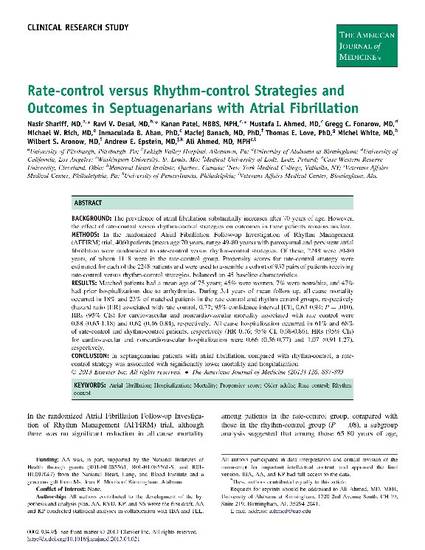
BACKGROUND: The prevalence of atrial fibrillation substantially increases after 70 years of age. However, the effect of rate-control versus rhythm-control strategies on outcomes in these patients remains unclear.
METHODS: In the randomized Atrial Fibrillation Follow-up Investigation of Rhythm Management (AFFIRM) trial, 4060 patients (mean age 70 years, range 49-80 years) with paroxysmal and persistent atrial fibrillation were randomized to rate-control versus rhythm-control strategies. Of these, 2248 were 70-80 years, of whom 1118 were in the rate-control group. Propensity scores for rate-control strategy were estimated for each of the 2248 patients and were used to assemble a cohort of 937 pairs of patients receiving rate-control versus rhythm-control strategies, balanced on 45 baseline characteristics.
RESULTS: Matched patients had a mean age of 75 years; 45% were women, 7% were nonwhite, and 47% had prior hospitalizations due to arrhythmias. During 3.4 years of mean follow-up, all-cause mortality occurred in 18% and 23% of matched patients in the rate-control and rhythm-control groups, respectively (hazard ratio [HR] associated with rate control, 0.77; 95% confidence interval [CI], 0.63-0.94; P = .010). HRs (95% CIs) for cardiovascular and noncardiovascular mortality associated with rate control were 0.88 (0.65-1.18) and 0.62 (0.46-0.84), respectively. All-cause hospitalization occurred in 61% and 68% of rate-control and rhythm-control patients, respectively (HR 0.76; 95% CI, 0.68-0.86). HRs (95% CIs) for cardiovascular and noncardiovascular hospitalization were 0.66 (0.56-0.77) and 1.07 (0.91-1.27), respectively.
CONCLUSION: In septuagenarian patients with atrial fibrillation, compared with rhythm-control, a rate-control strategy was associated with significantly lower mortality and hospitalization.
Shariff N, Desai RV, Patel K, Ahmed MI, Fonarow GC, Rich MW, Aban IB, Banach M, Love TE, White M, Aronow WS, Epstein AE, Ahmed A. Rate-control versus rhythm-control strategies and outcomes in septuagenarians with atrial fibrillation. Am J Med. 2013 Oct;126(10):887-93. doi: 10.1016/j.amjmed.2013.04.021. PMID: 24054956; PMCID: PMC3818786.
